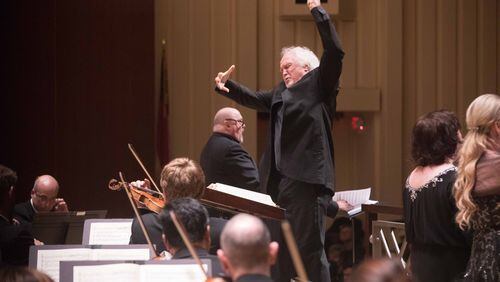The Atlanta Symphony Orchestra and Chorus, augmented by a quartet of exceptional guest artists, performed a work Thursday that was likely familiar to regular ASO patrons. It's barely been two years since Robert Spano conducted the piece to magnificent effect in the same hall, but in the case of Verdi's "Messa da Requiem," even two years may have been too long between performances.
In addition to the 2015 concert, Spano and the ASO also brought the piece to Symphony Hall audiences in 2010. For a change of pace, the ensemble took the show on the road to Carnegie Hall in 2006. This time around, principal guest conductor Donald Runnicles led the orchestra and chorus with soprano Erin Wall, mezzo-soprano Jamie Barton, bass Peter Rose and tenor Dimitri Pittas, who joined the ASO for its 2010 "Requiem" performance.
RELATED: AJC review of the ASO's 2015 performance
Verdi’s “Requiem” is a sure-fire crowd-pleaser, and it seemed to be a joy to sing and perform. The operatic masterwork is full of unbridled emotion and virtuosic singing. (Perhaps emphasizing the work’s opera bona fides, the Metropolitan Opera will stage its own version of the “Requiem” next week.)
It's sometimes difficult to put into words the excellence of the ASO Chorus, prepared by longtime director Norman Mackenzie. Put simply, the chorus is magnificent.
The piece starts at a pin-drop quiet dynamic in the low strings, with the chorus expertly matching that dynamic. For such a large chorus, sustaining a well-blended, quiet introduction is no small task, but the muted opening is extremely important. Those soft voices set up all the fire and brimstone to come in the “Dies Irae” and other robust passages — of which there are quite a few. But the forceful, double-forte moments are made more beautiful by the intense quiet, where entrances and cutoffs by the chorus and orchestra are magnified. Earth-shatteringly loud bits of music are reduced, abruptly, to serene episodes of solo vocal splendor. Under Runnicles’ careful attention, the orchestra and chorus performed as one, deftly emphasizing these huge dynamic contrasts with expert attention.
While the chorus, which is arguably the crown jewel of the symphony, was the main attraction of the Verdi, the orchestra played with both a bone-rattling authority and a sublime sweetness. In just one instance of instrumental mastery, during the fanfare in the “Dies Irae,” four trumpets were positioned in the balcony for an immersive musical experience. Dolby Surround Sound has nothing on the ASO.
Of course, the choral and orchestral musicians can’t carry the Verdi by themselves. The exquisite mezzo-soprano Barton and the thundering bass Rose proved the standouts in an impressive collection of soloists. Barton’s vocal grain is somehow both dark and bright, radiant and cloudy at the same time; in the many duets with soprano Wall, it was easy to hear that the wonder of Verdi’s “Requiem” comes not from the roaring choral singing, but these sublime, intensely moving pairings.
Runnicles' most recent appearance with the chorus, in May, included a different "Requiem" by composer Gabriel Faure. In February, the orchestra and chorus will perform Mozart's "Requiem" — which is, by comparison to the Verdi, buttoned-up and restrained, but no less moving. Mounting requiems at a pace of one a year — the last Mozart performance came during the 2014-2015 season — may keep other fare from the stage, but as long as Spano remains dedicated to bringing in new works, is there anything wrong with having the ASO play the hits?
CONCERT REVIEW
“Messa da Requiem”
8 p.m. Nov. 16. Additional performance at 8 p.m. Nov. 18. $64-$97. Symphony Hall, 1280 Peachtree St. N.E., Atlanta. 404-733-5000, www.atlantasymphony.org.
IN OTHER MUSIC NEWS:


/cloudfront-us-east-1.images.arcpublishing.com/ajc/P7DYBH6TO7FEKG4SUXQQKADRXE.jpg)



